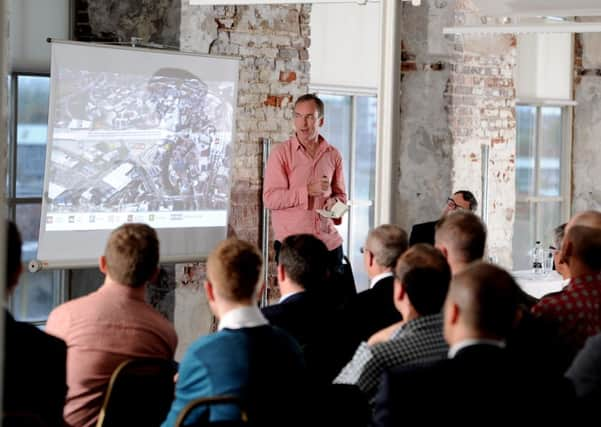State-owned RBS ‘blighting regeneration’ of key site in Yorkshire


Leeds City Council wants to transform the former industrial heart of the city into a 21st century community with family-friendly homes, open spaces and transport connections linking to the new train station for HS2.
But developers, investors and academics are concerned at the impact that “absentee landowners” are having on plans for the area known as the South Bank. These include Royal Bank of Scotland, which is 80 per cent owned by the taxpayer.
Advertisement
Hide AdAdvertisement
Hide AdRBS took ownership of a key site in Holbeck in 2009 after calling in a loan to developer EMCO Estates Holdings. The company claimed the move forced it into liquidation. The asset is now held in West Register, the bank’s controversial property portfolio.
The unit is being wound down and sold off after RBS was criticised over perceived conflicts of interest when buying properties after a restructuring process.
Peter Connolly, who has led efforts to regenerate former industrial areas of Leeds through his company Yorkshire Design Group, raised concerns that a strategic site in the city will be “dumped on the market” and not considered as part of wider plans for the South Bank.
He claimed that a primary area for development “is being blighted by Government action” through its ownership of RBS.
Advertisement
Hide AdAdvertisement
Hide AdMr Connolly made the comments at a how-to event on successful cities hosted by The Yorkshire Post Business Club.
The debate took place at Marshalls Mill, one of the sites developed by Igloo Regeneration, a major investor in the South Bank over the last decade. Other Igloo schemes include the Round Foundry and Granary Wharf.
Chris Brown, founder and chief executive, told the audience: “If you look around here at who owns the land, it is a combination of publicly-owned banks, developers - some based outside the country - and the city council.
“I would vote for the city council having ownership of all the land. Unless you have it all in one place... collaboration won’t do it.”
Advertisement
Hide AdAdvertisement
Hide AdMr Brown called on the local authority to use its ability to borrow cheaply to buy out those landowners sitting on plots and help kickstart activity.
Asked if the council had the stomach for this action, Richard Lewis, the councillor responsible for city development, said: “Prudential borrowing is something we can do now. I have to say there is always a cost for us in that.”
He said the council had to consider wider issues such as political acceptability as well as its balance sheet. But Coun Lewis added: “I think here, on the South Bank, there is always going to be a good business case.”
Rachael Unsworth, an urban geographer, warned that unless the city deals with “the phenomenon of absentee landowners” it will not achieve the full potential of the South Bank.
Advertisement
Hide AdAdvertisement
Hide AdA spokeswoman for RBS told The Yorkshire Post: “West Register has ownership of 6.5 acres of land at Holbeck, but we are not in a position to comment further on our plans at this current time.”
More than 110 people attended today’s event.
It helps to have a billionaire mayor
As Mayor of New York City, Michael Bloomberg had a clock on the wall of his office with the time ticking down to December 21 2013, the date he would leave the post.
This is how much time we have, he would tell staff, pointing to the clock.
“It helps to have a billionaire mayor,” said Allison Dutoit. “But it also helps to have that kind of vision and clock.”
Advertisement
Hide AdAdvertisement
Hide AdMr Bloomberg introduced innovative policies and initiatives during his time in office.
Ms Dutoit is an associate at Gehl Architects, a global leader in urban design. Her firm was brought in to look at the use of space in NYC in an effort to improve quality of life in the densely populated city.
Speaking at The Yorkshire Post Business Club yesterday, Ms Dutoit said: “One of the interesting things is looking at the physical amount of space that was given in public areas and how it was used and often we found a complete flip.
“One of the biggest discoveries is there is no square at Times Square. 89 per cent is given to road space. 11 per cent is people space. We were astonished by this. Times Square is made up of nearly 90 per cent pedestrians and 11 per cent road users. The question became, who are we giving space to?”
Advertisement
Hide AdAdvertisement
Hide AdNYC introduced pedestrian-friendly improvements that led to a 17 per cent reduction in traffic time, an increase in retail sales and a decrease in shop vacancy rates.
Gehl is headquartered in Copenhagen, ranked as one of the world’s most liveable cities.
Ms Dutoit said the city is like a laboratory for its design consultancy work across the world.
To be successful, cities must quantify quality of life issues - “what gets measured gets done” - leverage existing assets and build up trust in public institutions, she added.
Even the Crown Prince is a cyclist
Advertisement
Hide AdAdvertisement
Hide AdIn Copenhagen, 50 per cent of people cycle to school or work.
Of those, 63 per cent do so because it is the most convenient form of transport. Even the Crown Prince cycles around the city, according to Ms Dutoit.
Speaking at The Yorkshire Post Business Club, Christian Townsley, a director at North Bar Ltd, said making it safer for cyclists and pedestrians would make a huge difference to Leeds.
Councillor Richard Lewis said: “We want a city centre where people can cycle and people can use pushchairs and just walk around. But we do have to make that happen in a way where the lycra nutcases thinking this is a freeway for them. We have to make it happen.”